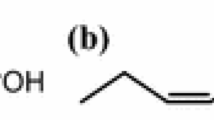Abstract
The lipolysate from immobilizedRhizomucor miehei lipase (Lipozymetm)-catalyzed hydrolysis of lesquerella oil contains typically 35% free fatty acid (FFA), 2% monoglyceride, 25% diglyceride (DG), and 38% triglyceride (TG). Of the FFA, 75–80% are hydroxy acids (HFA). Various methods for isolating HFA from the lipolysate were examined, and a novel saponification/extraction method was developed. Lipolysate was mixed with 4 vol equivalents each of KOH/phosphate buffer and polar organic solvent. Hexane was then added to enhance phase separation. Three phases formed: a lower aqueous phase containing nothing of interest, a polar organic solvent middle phase that contained mostly fatty acid soaps, and a hexane-rich upper phase that contained mostly DG and TG, which can be recycled to a relipolysis step. The middle phase, when treated with concentrated hydrochloric acid, NaCl-saturated water, and hexane, released the FFA into the hexane. This fraction, referred to as the “Product” contained >99% of the FFA released in the lipolysis. “Product” consisted of 85–90% FFA, of which 75–80% was HFA. The other 10–15% of the “Product” consisted of partial glycerides and TG. The most critical parameters for the extraction are the pH of the aqueous solution and the polarity of the organic solvent (acetone was found to be the best choice). Additional purification steps for the “Product” are discussed.
Similar content being viewed by others
References
Roetheli, J.C., K.D. Carlson, R. Kleiman, A.E. Thompson, D.A. Dierig, L.K. Glaser, M.G. Blase, and J. Goodell, inLesquerella as a Source of Hydroxy Fatty Acids for Industrial Products, Government Publication Series, USDA, CSRS, Washington, D.C., 1991.
Carlson, K.D., A. Chaudhry, R.E. Peterson, and M.O. Bagby, Preparative Chromatographic Isolation of Hydroxy Acids fromLesquerella fendleri andL. gordonii Seed Oils.J. Am. Oil Chem. Soc. 67:495–498 (1990).
Hayes, D.G., and R. Kleiman, Recovery of Hydroxy Fatty Acids from Lesquerella Oil with Lipases,69:982–985 (1992).
Hayes, D.G., and R. Kleiman, 1,3-Specific Lipolysis ofLesquerella fendleri Oil by Immobilized and Reverse Micellar Encapsulated Lipases,70:1121–1127 (1993).
Coleman, M.H., and A.R. Macrae, Fat Process and Composition, U.S. Patent 4,275,081 (1981).
Quinlan, P., and S. Moore, Modification of Triglycerides by Lipases: Process Technology and Its Application to the Production of Nutritionally Improved Fats,INFORM 4:580–585 (1992).
Derksen, J.T.P., G. Boswinkel, W.M.J. van Gelder, K. van’t Riet, and F.P. Cuperus, Enzymatic Processing of Triglycerides and Fatty Acids. Enhancing Reaction Kinetics by Continuous Product Removal, inDeveloping Agricultural Biotechnology in the Netherlands, edited by D.H. Vuijk, J.J. Dekkers, and H.C. van der Plas, Pudoc Scientific Publishing, Wageningen, The Netherlands, 1993, pp. 220–274.
Derksen, J.T.P., S.T. Bouwer, and F.P. Cuperus, Enzyme Bioreactor-Mediated Production of Functionalized Fatty Acids [Abstract],INFORM 4:540 (1993).
Christie, W.W.,Liquid Analysis: Isolation, Separation, and Structural Analysis of Lipids, Oxford, Pergamon Press, 1973.
Perkins, E.G. (ed.),Analyses of Fats, Oils, and Derivatives, AOCS Press, Champaign, 1993.
Hayes, D.G., and R. Kleiman, Supercritical Fluid Chromatographic Analysis of New Crop Seed Oils and Their Reactions,J. Am. Oil Chem. Soc., in press, 1996.
Cannon, J.A., K.T. Zilch, and H.J. Dutton, Countercurrent Distribution of Methyl Esters of Higher Fatty Acids,Anal. Chem. 24:1530–1532 (1952).
Frankel, E.N., D.G. McConnell, and C.D. Evans, Analyses of Lipids and Oxidation Products by Partition chromatography: Hydroxy Fatty Acids and Esters,J. Am. Oil Chem. Soc. 39:297–301 (1962).
Rusling, J.F., R.J. Bertsch, R.A. Barford, and H.L. Rothbart, Liquid Equilibria in the System Methyl Oleate-Methyl Palmitate-Acetonitrile-Hexane,J. Chem. Engr. Data 14:169–173 (1969).
Lide, D.R. (ed.),handbook of Chemistry and Physics (73rd edn.), CRC Press, Boca Raton, 1992.
Laane, C., S. Boeren, K. Vos, and C. Veeger, Rules for Optimization of Biocatalysis in Organic Solvents,Biotechnol. Bioeng. 30:81–87 (1987).
Taft, R.W., M.H. Abraham, G.R. Famini, R.M. Doherty, J.L.M. Abboud, and M.J. Kamlet, Solubility Properties in Polymers and Biological Media 5: An Analysis of the Physicochemical Properties Which Influence Octanol-Water Partition Coefficients of Aliphatic and Aromatic Solutes,J. Pharm. Sci. 74:807–814 (1985).
Hayes, D.G., and R. Kleiman, Lipase-Catalyzed Synthesis and Properties of Estolides and Their Esters.J. Am. Oil Chem. Soc. 72:1309–1316 (1995).
Hayes, D.G., and R. Kleiman, Lipase-Catalyzed Synthesis of Lesquerolic Acid Wax and Diol Esters and Their Properties,Ibid., J. Am. Oil Chem. Soc., in press, 1996.
Author information
Authors and Affiliations
About this article
Cite this article
Hayes, D.G., Carlson, K.D. & Kleiman, R. The isolation of hydroxy acids from lesquerella oil lipolysate by a saponification/extraction technique. J Am Oil Chem Soc 73, 1113–1119 (1996). https://doi.org/10.1007/BF02523371
Received:
Revised:
Issue Date:
DOI: https://doi.org/10.1007/BF02523371




